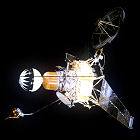 NASA launches the Ranger 5 lunar probe, built by Jet Propulsion Laboratory and intended to go directly to the moon, transmitting pictures of the surface back to Earth until it impacts the lunar surface. An onboard system failure cuts off solar power, leaving Ranger 5 on its limited supply of battery power; by the time it reaches the moon, its power-starved systems have shut down and it’s wide of the mark, missing the moon by 450 miles. A sweeping internal review of the Ranger program commences at both JPL and NASA, with the review boards finding design faults and discovering that the high-heat sterilization process, intended to keep Earthly microbes from contaminating the moon, may also be causing problems. With Ranger now considered a support program for the upcoming Apollo flights to the moon, NASA is under intense scrutiny and replaces the managers of the Ranger project prior to the next launch, also instituting another redesign of the spacecraft.
NASA launches the Ranger 5 lunar probe, built by Jet Propulsion Laboratory and intended to go directly to the moon, transmitting pictures of the surface back to Earth until it impacts the lunar surface. An onboard system failure cuts off solar power, leaving Ranger 5 on its limited supply of battery power; by the time it reaches the moon, its power-starved systems have shut down and it’s wide of the mark, missing the moon by 450 miles. A sweeping internal review of the Ranger program commences at both JPL and NASA, with the review boards finding design faults and discovering that the high-heat sterilization process, intended to keep Earthly microbes from contaminating the moon, may also be causing problems. With Ranger now considered a support program for the upcoming Apollo flights to the moon, NASA is under intense scrutiny and replaces the managers of the Ranger project prior to the next launch, also instituting another redesign of the spacecraft.
 NASA launches the Ranger 1 lunar probe, designed to test a new vehicle configuration to reach the moon, transmitting pictures back to Earth as it falls toward impact on the lunar surface. The Agena second stage rocket designed to push Ranger 1 into a much higher orbit to escape Earth’s gravity fails, and Ranger 1 falls back into Earth’s atmosphere, disintegrating eight days after launch. This is the first of a series of setbacks for the troubled Ranger program.
NASA launches the Ranger 1 lunar probe, designed to test a new vehicle configuration to reach the moon, transmitting pictures back to Earth as it falls toward impact on the lunar surface. The Agena second stage rocket designed to push Ranger 1 into a much higher orbit to escape Earth’s gravity fails, and Ranger 1 falls back into Earth’s atmosphere, disintegrating eight days after launch. This is the first of a series of setbacks for the troubled Ranger program.
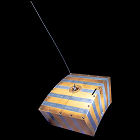 OSCAR-1, an experimental satellite designed and built by amateur radio engineers for a technology test, is launched as a secondary payload aboard an Air Force rocket whose primary payload is a reconnaissance satellite. This is the first launch in history with a secondary payload, and the first payload not developed by a specific government or its agencies. The amateur radio engineers of Project OSCAR built the simple transmitter satellite for a grand total of $35, with a finite battery life and no attitude control thrusters of any kind, to transmit the message “HI” in the 2-meter band until the battery expired (which happens a few weeks before the satellite re-enters Earth’s atmosphere in late January 1962). A nearly-identical OSCAR-2 satellite will be launched in June 1962, while OSCAR-3, launched in 1965, is capable of receiving and retransmitting signals.
OSCAR-1, an experimental satellite designed and built by amateur radio engineers for a technology test, is launched as a secondary payload aboard an Air Force rocket whose primary payload is a reconnaissance satellite. This is the first launch in history with a secondary payload, and the first payload not developed by a specific government or its agencies. The amateur radio engineers of Project OSCAR built the simple transmitter satellite for a grand total of $35, with a finite battery life and no attitude control thrusters of any kind, to transmit the message “HI” in the 2-meter band until the battery expired (which happens a few weeks before the satellite re-enters Earth’s atmosphere in late January 1962). A nearly-identical OSCAR-2 satellite will be launched in June 1962, while OSCAR-3, launched in 1965, is capable of receiving and retransmitting signals. NASA launches the Ranger 3 lunar probe, built by Jet Propulsion Laboratory and intended to go directly to the moon, transmitting pictures of the surface back to Earth until it impacts the lunar surface. This modified Ranger spacecraft design also includes a balsa wood sphere, containing seismic detection experiments, which is intended to be blasted free of the main spacecraft and impact the moon separately. A problem with the Agena second stage booster puts Ranger 3 on the wrong heading with too much acceleration, missing the moon by 22,000 miles. With three straight failures to send a costly probe to the moon, NASA’s future and the future of its lunar exploration program is now under government review.
NASA launches the Ranger 3 lunar probe, built by Jet Propulsion Laboratory and intended to go directly to the moon, transmitting pictures of the surface back to Earth until it impacts the lunar surface. This modified Ranger spacecraft design also includes a balsa wood sphere, containing seismic detection experiments, which is intended to be blasted free of the main spacecraft and impact the moon separately. A problem with the Agena second stage booster puts Ranger 3 on the wrong heading with too much acceleration, missing the moon by 22,000 miles. With three straight failures to send a costly probe to the moon, NASA’s future and the future of its lunar exploration program is now under government review.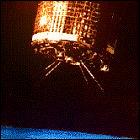 NASA and the United States Weather Bureau launch the fourth experimental TIROS weather satellite, TIROS-4. Further refinements to the basic TIROS satellite system are made, and after TIROS-3’s discovery of a hurricane in the Atlantic well before it his the US, new enhancements are introduced specifically for early hurricane detection. TIROS-4 remains in orbit for less than six months.
NASA and the United States Weather Bureau launch the fourth experimental TIROS weather satellite, TIROS-4. Further refinements to the basic TIROS satellite system are made, and after TIROS-3’s discovery of a hurricane in the Atlantic well before it his the US, new enhancements are introduced specifically for early hurricane detection. TIROS-4 remains in orbit for less than six months.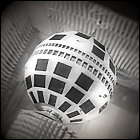 The first Telstar communications satellite is launched, the first attempt to forge a permanent trans-Atlantic telecommunications link with an satellite that both receives and actively retransmits signals. A multinational venture between communications companies and government agencies in America, England and France, Telstar relays the first live trans-Atlantic television broadcast, bringing together the three major American networks of the time and the BBC for a one-of-a-kind joint news broadcast. Live intercontinental telephone calls and other TV broadcasts are also handled by Telstar. Though it’s an experimental satellite, Tesltar is expected to remain in service for some time, but its operational life is reduced to less than a year by, among other things, the effects of high-altitude nuclear weapons tests. Telstar shuts down in February 1963, but remains in orbit to this day.
The first Telstar communications satellite is launched, the first attempt to forge a permanent trans-Atlantic telecommunications link with an satellite that both receives and actively retransmits signals. A multinational venture between communications companies and government agencies in America, England and France, Telstar relays the first live trans-Atlantic television broadcast, bringing together the three major American networks of the time and the BBC for a one-of-a-kind joint news broadcast. Live intercontinental telephone calls and other TV broadcasts are also handled by Telstar. Though it’s an experimental satellite, Tesltar is expected to remain in service for some time, but its operational life is reduced to less than a year by, among other things, the effects of high-altitude nuclear weapons tests. Telstar shuts down in February 1963, but remains in orbit to this day.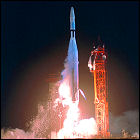 NASA launches the JPL-built unmanned space probe Mariner 1, the first of two identical spacecraft intended to study the planet Venus. Mariner 1’s mission, however, is cut short before it even leaves Earth’s atmosphere: a communication loss between its Atlas-Agena booster rocket and ground-based control systems sends the rocket off course. Fearing that it might tumble into the Atlantic Ocean’s heavily traveled shipping lanes, NASA orders the vehicle to self-destruct in mid-air. Many later accounts lay the blame at an error in the code loaded into the rocket’s on-board guidance computer. Mariner 1’s mission objectives are transferred to its identical twin, Mariner 2, due to be launched in just over a month.
NASA launches the JPL-built unmanned space probe Mariner 1, the first of two identical spacecraft intended to study the planet Venus. Mariner 1’s mission, however, is cut short before it even leaves Earth’s atmosphere: a communication loss between its Atlas-Agena booster rocket and ground-based control systems sends the rocket off course. Fearing that it might tumble into the Atlantic Ocean’s heavily traveled shipping lanes, NASA orders the vehicle to self-destruct in mid-air. Many later accounts lay the blame at an error in the code loaded into the rocket’s on-board guidance computer. Mariner 1’s mission objectives are transferred to its identical twin, Mariner 2, due to be launched in just over a month.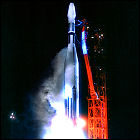 NASA launches its first interplanetary spacecraft, the unmanned space probe Mariner 2, en route to Venus. During its three-month trip from Earth to Venus, Mariner 2 takes measurements of solar wind, charged particles, and an experiment is included to measure the amount of dust and micrometeoroids between the two planets. The probe briefly loses attitude control several times in flight, but regains proper orientation in each instance.
NASA launches its first interplanetary spacecraft, the unmanned space probe Mariner 2, en route to Venus. During its three-month trip from Earth to Venus, Mariner 2 takes measurements of solar wind, charged particles, and an experiment is included to measure the amount of dust and micrometeoroids between the two planets. The probe briefly loses attitude control several times in flight, but regains proper orientation in each instance.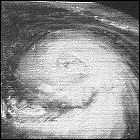 NASA and the United States Weather Bureau launch the sixth experimental TIROS weather satellite, TIROS-6. Launched specifically to allow for better detection of storms during the 1962 Atlantic hurricane season, TIROS-6 has a full workload within days of launch as Hurricane Daisy forms in the Caribbean Sea and makes its way to New England. TIROS-6 finally provides a successful test for NASA’s attempts to keep a weather satellite in service for long-duration missions, lasting over a year in orbit.
NASA and the United States Weather Bureau launch the sixth experimental TIROS weather satellite, TIROS-6. Launched specifically to allow for better detection of storms during the 1962 Atlantic hurricane season, TIROS-6 has a full workload within days of launch as Hurricane Daisy forms in the Caribbean Sea and makes its way to New England. TIROS-6 finally provides a successful test for NASA’s attempts to keep a weather satellite in service for long-duration missions, lasting over a year in orbit.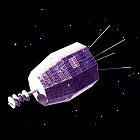 NASA launches the experimental, RCA-built Relay 1 communications satellite. This is the first satellite to relay television signals from the United States to Japan, including the first word of the assassination of President Kennedy in
NASA launches the experimental, RCA-built Relay 1 communications satellite. This is the first satellite to relay television signals from the United States to Japan, including the first word of the assassination of President Kennedy in 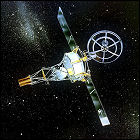 NASA’s unmanned Mariner 2 probe is the first unmanned spacecraft to successfully reach and take measuresments of another planet in the solar system. Passing by Venus at a distance of 25,000 miles, Mariner 2 detects a cool atmosphere with a blistering hot surface underneath it – quickly dispelling any hopes of finding life there. Mariner 2 isn’t equipped with any cameras, which is just as well: unless any cameras had ultraviolet filters, they would have seen nothing but featureless clouds at Venus. Mariner 2 continues on into a solar orbit, shutting down early in 1963.
NASA’s unmanned Mariner 2 probe is the first unmanned spacecraft to successfully reach and take measuresments of another planet in the solar system. Passing by Venus at a distance of 25,000 miles, Mariner 2 detects a cool atmosphere with a blistering hot surface underneath it – quickly dispelling any hopes of finding life there. Mariner 2 isn’t equipped with any cameras, which is just as well: unless any cameras had ultraviolet filters, they would have seen nothing but featureless clouds at Venus. Mariner 2 continues on into a solar orbit, shutting down early in 1963.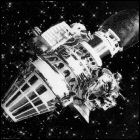 An unmanned Soviet lunar lander, Luna 4, is launched from the USSR’s Baikonur Cosmodrome. Unlike Luna 2, which intentionally crashed into the moon with no attempt to slow its approach, Luna 4 is the first atempt at a vehicle intended to survive its descent to the lunar surface and make observations from the ground. A failed course correction engine burn leaves the 3,000-pound vehicle in a wide, looping orbit around the Earth, unable to reach the moon at all. The Soviet Union, after several more attempts, will eventually achieve the first unmanned soft landing on the surface of the moon three years later.
An unmanned Soviet lunar lander, Luna 4, is launched from the USSR’s Baikonur Cosmodrome. Unlike Luna 2, which intentionally crashed into the moon with no attempt to slow its approach, Luna 4 is the first atempt at a vehicle intended to survive its descent to the lunar surface and make observations from the ground. A failed course correction engine burn leaves the 3,000-pound vehicle in a wide, looping orbit around the Earth, unable to reach the moon at all. The Soviet Union, after several more attempts, will eventually achieve the first unmanned soft landing on the surface of the moon three years later.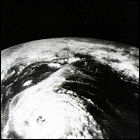 NASA and the United States Weather Bureau launch the seventh experimental TIROS weather satellite, TIROS-7. In addition to observing weather on Earth, TIROS-7 carries instruments to measure electron activity in Earth’s vicinity and to measure the temperature of space. Enhancements designed to extend the satellite’s life prove to be wildly successful: TIROS-7 is the longest-lived of the experimental TIROS series, remaining in service for five years (and, critically, five hurricane seasons).
NASA and the United States Weather Bureau launch the seventh experimental TIROS weather satellite, TIROS-7. In addition to observing weather on Earth, TIROS-7 carries instruments to measure electron activity in Earth’s vicinity and to measure the temperature of space. Enhancements designed to extend the satellite’s life prove to be wildly successful: TIROS-7 is the longest-lived of the experimental TIROS series, remaining in service for five years (and, critically, five hurricane seasons).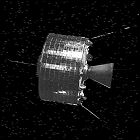 NASA launches the experimental, Hughes Aircraft-built communications satellite Syncom 2 into a geosynchronous orbit, the first human-made satellite to occupy that orbit. (Syncom 1, launched in February, malfunctioned on its way to that orbit, so technically it could be considered the first, though it didn’t arrive in geosynchronous orbit in a functional state.) Capable of handling either a single two-way telephone call, or up to 16 simultaneous teletype transmissions. Early fax transmission tests were also carried out. Syncom 2 could also transmit low-quality video, but with no audio. Control of Syncom 2 is handed over to the Department of Defense in
NASA launches the experimental, Hughes Aircraft-built communications satellite Syncom 2 into a geosynchronous orbit, the first human-made satellite to occupy that orbit. (Syncom 1, launched in February, malfunctioned on its way to that orbit, so technically it could be considered the first, though it didn’t arrive in geosynchronous orbit in a functional state.) Capable of handling either a single two-way telephone call, or up to 16 simultaneous teletype transmissions. Early fax transmission tests were also carried out. Syncom 2 could also transmit low-quality video, but with no audio. Control of Syncom 2 is handed over to the Department of Defense in 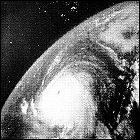 NASA and the United States Weather Bureau launch the eighth experimental TIROS weather satellite, TIROS-8. With TIROS-7 still fully operational, TIROS-8 expands coverage of Earth’s weather (including early detection and tracking of Hurricane Betsy, the first hurricane in American history to cause over $1,000,000,000 in damage) and tests new technology, including a high resolution, slow-scan imaging system. TIROS-8 is the second longest-lived of the early experimental TIROS satellites, remaining in service for three and a half years.
NASA and the United States Weather Bureau launch the eighth experimental TIROS weather satellite, TIROS-8. With TIROS-7 still fully operational, TIROS-8 expands coverage of Earth’s weather (including early detection and tracking of Hurricane Betsy, the first hurricane in American history to cause over $1,000,000,000 in damage) and tests new technology, including a high resolution, slow-scan imaging system. TIROS-8 is the second longest-lived of the early experimental TIROS satellites, remaining in service for three and a half years.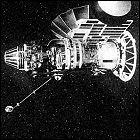 The Soviet Union launches the space probe Zond 1 toward Venus, a more sophisticated version of the Venera 1 vehicle sent to that planet in 1961. Thanks to an electrical short within the Zond space probe, ground controllers lose all contact a month after it leaves Earth; by the time it swings past Venus at over 60,000 miles months later, Zond 1 has shut down completely.
The Soviet Union launches the space probe Zond 1 toward Venus, a more sophisticated version of the Venera 1 vehicle sent to that planet in 1961. Thanks to an electrical short within the Zond space probe, ground controllers lose all contact a month after it leaves Earth; by the time it swings past Venus at over 60,000 miles months later, Zond 1 has shut down completely.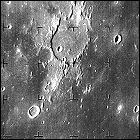 NASA launches the Ranger 7 lunar probe, built by Jet Propulsion Laboratory and intended to go directly to the moon, transmitting pictures of the surface back to Earth until it impacts the lunar surface. Months of building system redundancies into the Ranger spacecraft have made this vehicle more likely to carry out its mission, and it becomes the first of the Ranger probes to reach the moon with its eyes open. Pictures are transmitted back to Earth as Ranger 7 plunges into the lunar surface near the Ocean of Storms, with photo resolution exceeding expectations. One of the ground controllers at JPL breaks open a jar of peanuts during Ranger 7’s final approach to the moon, starting a JPL tradition that lasts to this day.
NASA launches the Ranger 7 lunar probe, built by Jet Propulsion Laboratory and intended to go directly to the moon, transmitting pictures of the surface back to Earth until it impacts the lunar surface. Months of building system redundancies into the Ranger spacecraft have made this vehicle more likely to carry out its mission, and it becomes the first of the Ranger probes to reach the moon with its eyes open. Pictures are transmitted back to Earth as Ranger 7 plunges into the lunar surface near the Ocean of Storms, with photo resolution exceeding expectations. One of the ground controllers at JPL breaks open a jar of peanuts during Ranger 7’s final approach to the moon, starting a JPL tradition that lasts to this day.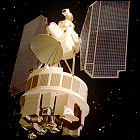 NASA and the United States Weather Bureau launch the first test article of the next-generation weather satellite, Nimbus-1. Using the more advanced camera technology (including infrared filters to watch cloud motion even on Earth’s night side) tested aboard TIROS-8, Nimbus-1 provides a vast improvement on satellite weather observations over the hardware on the TIROS experimental satellites. The first Nimbus satellite remains in service for only a month; later Nimbus satellites continue to be launched into service well into the late 1970s, and most of them remain operational into the 1980s.
NASA and the United States Weather Bureau launch the first test article of the next-generation weather satellite, Nimbus-1. Using the more advanced camera technology (including infrared filters to watch cloud motion even on Earth’s night side) tested aboard TIROS-8, Nimbus-1 provides a vast improvement on satellite weather observations over the hardware on the TIROS experimental satellites. The first Nimbus satellite remains in service for only a month; later Nimbus satellites continue to be launched into service well into the late 1970s, and most of them remain operational into the 1980s.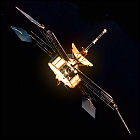 Though successfully launched, NASA’s
Though successfully launched, NASA’s 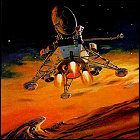 Following up on preliminary studies assuming almost-Earthlike conditions, NASA commences work on a major robotic interplanetary landing mission called Voyager, which will use a Saturn IB rocket to send an orbiter with two landers to Mars. But NASA is doing so without much help from its usual interplanetary think-tank, Jet Propulsion Laboratory, whose scientists warn NASA that the latest astronomical data suggests a significantly thinner atmosphere and lower atmospheric pressure than the scenario for which NASA is designing its vehicles. As the complexity involved in creating self-guided landers with on-board laboratories increases, contractors begin to insist that only a Saturn V will do; since all Saturn V boosters are currently in reserve for Apollo lunar missions, NASA pushes the Voyager mission back into the 1970s.
Following up on preliminary studies assuming almost-Earthlike conditions, NASA commences work on a major robotic interplanetary landing mission called Voyager, which will use a Saturn IB rocket to send an orbiter with two landers to Mars. But NASA is doing so without much help from its usual interplanetary think-tank, Jet Propulsion Laboratory, whose scientists warn NASA that the latest astronomical data suggests a significantly thinner atmosphere and lower atmospheric pressure than the scenario for which NASA is designing its vehicles. As the complexity involved in creating self-guided landers with on-board laboratories increases, contractors begin to insist that only a Saturn V will do; since all Saturn V boosters are currently in reserve for Apollo lunar missions, NASA pushes the Voyager mission back into the 1970s. NASA and the United States Weather Bureau launch the ninth experimental TIROS weather satellite, TIROS-9. Heavier than any of the other TIROS experimental satellites, and with cameras mounted on opposite sides of the satellite’s cylindrical body to keep the Earth in view at all times. The result, in February, is the first-ever snapshot of the entire world’s weather patterns within a single day. TIROS-9 also carries other upgrades being considered for an upcoming fleet of full-time operational weather satellites, and remains in service for three and a half years.
NASA and the United States Weather Bureau launch the ninth experimental TIROS weather satellite, TIROS-9. Heavier than any of the other TIROS experimental satellites, and with cameras mounted on opposite sides of the satellite’s cylindrical body to keep the Earth in view at all times. The result, in February, is the first-ever snapshot of the entire world’s weather patterns within a single day. TIROS-9 also carries other upgrades being considered for an upcoming fleet of full-time operational weather satellites, and remains in service for three and a half years.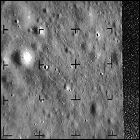 NASA launches the Ranger 8 lunar probe, built by Jet Propulsion Laboratory and intended to go directly to the moon, transmitting pictures of the surface back to Earth until it impacts the lunar surface. Ranger 8 functions flawlessly, sending pictures back to Earth until it slams into the Sea of Tranquility at high speed. Over 7,000 photos are returned, with the last complete picture transmitted prior to impact showing lunar surface features as small as five feet across.
NASA launches the Ranger 8 lunar probe, built by Jet Propulsion Laboratory and intended to go directly to the moon, transmitting pictures of the surface back to Earth until it impacts the lunar surface. Ranger 8 functions flawlessly, sending pictures back to Earth until it slams into the Sea of Tranquility at high speed. Over 7,000 photos are returned, with the last complete picture transmitted prior to impact showing lunar surface features as small as five feet across.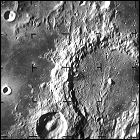 NASA launches the Ranger 9 lunar probe, built by Jet Propulsion Laboratory and intended to go directly to the moon, transmitting pictures of the surface back to Earth until it impacts the lunar surface. Despite NASA scientists’ insistence that the last Ranger probe carry scientific instruments and not just cameras, Ranger 9 is outfitted with cameras only; as a tradeoff, scientists get to nominate its target on the surface, selecting the crater Alphonsus, suspected to be a site of lunar volcanism. Ranger 8 functions flawlessly, sending live video back to Earth until impacting in the crater floor, and for the first time the terminal descent of one of the Ranger probes is broadcast live on TV. This concludes the Ranger program, as NASA now needs to switch its efforts to the unmanned Surveyor lunar landers to find out if the moon’s surface can support the weight of a manned lander. The basic architecture of the Ranger spacecraft is adopted as the heart of the ongoing Mariner planetary space probe series, up to and including the Mariner Jupiter/Saturn ’77 missions (later renamed Voyager) over a decade later.
NASA launches the Ranger 9 lunar probe, built by Jet Propulsion Laboratory and intended to go directly to the moon, transmitting pictures of the surface back to Earth until it impacts the lunar surface. Despite NASA scientists’ insistence that the last Ranger probe carry scientific instruments and not just cameras, Ranger 9 is outfitted with cameras only; as a tradeoff, scientists get to nominate its target on the surface, selecting the crater Alphonsus, suspected to be a site of lunar volcanism. Ranger 8 functions flawlessly, sending live video back to Earth until impacting in the crater floor, and for the first time the terminal descent of one of the Ranger probes is broadcast live on TV. This concludes the Ranger program, as NASA now needs to switch its efforts to the unmanned Surveyor lunar landers to find out if the moon’s surface can support the weight of a manned lander. The basic architecture of the Ranger spacecraft is adopted as the heart of the ongoing Mariner planetary space probe series, up to and including the Mariner Jupiter/Saturn ’77 missions (later renamed Voyager) over a decade later.